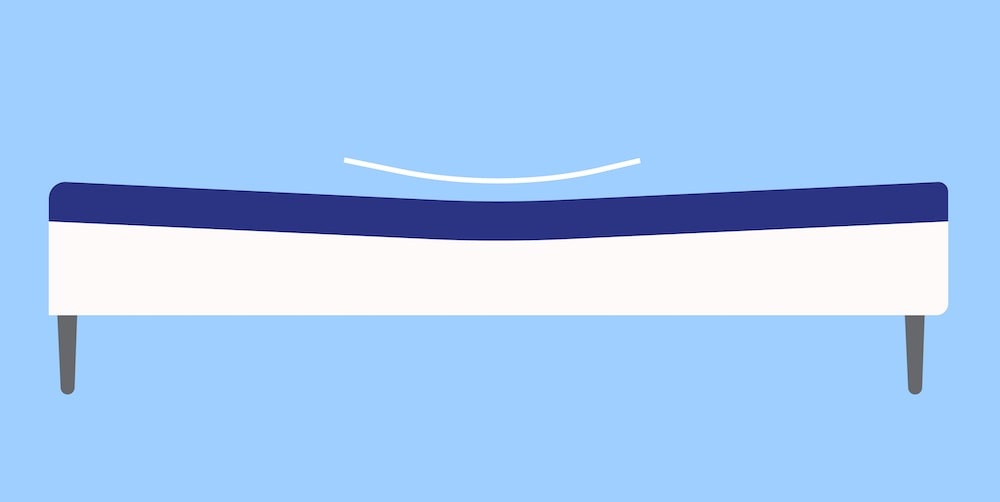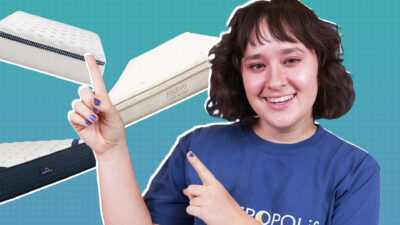
Have you ever woken up on your trusty old mattress to discover new aches and pains starting to pop up? When the middle of your bed starts to feel like quicksand or you start noticing new back and hip pains in the mornings, your mattress might be sagging. In addition to causing soreness, a sagging mattress can also hurt the quality of your sleep — so it’s important to fix this problem as soon as possible.
Don’t start dragging your mattress to the curb just yet — there are lots of reasons why your mattress might be sagging, and lots of different solutions you can try before you start mattress shopping. In this article, we’ll go over the most common causes of a sagging bed and a few solutions you can try. If your mattress has lived out its life and is ready for retirement, we’ll provide you with some guides to help you choose a quality bed and shop sales to get the most bang for your buck.
Why Is My Mattress Sagging?
There are lots of reasons why your mattress might be sagging. Let’s go over some of the most common ones below.
Regular Wear And Tear
If you sleep in the same spot every night, your body weight will eventually wear down even the most durable mattress. This is especially the case if you stay in the same sleeping position every night.
Sleeping With A Partner
The weight of two bodies will wear down your mattress faster than one — especially if you tend to cuddle in the same spot on the bed every night.
Weight Gain
Sleepers with heavier body types need a more supportive bed, and if your body type has changed over the years, your mattress might not cut it anymore.
Low-Quality Bed
When it comes to mattress shopping, you often get what you pay for. A cheap mattress is often made with lower quality materials and weaker edge support, so it will break down much faster than a high-quality bed.
The Wrong Support
Different mattresses require different foundations. If you don’t choose the right bed frame, box spring, or foundation as designated by your bed’s manufacturer, your mattress will deteriorate more quickly. Choosing the right support for your mattress is also important because using the wrong foundation for your bed could potentially void your warranty.
Sleeping With Pets
If Fido has a designated spot on the bed, this area of your mattress will start to break down faster as well — especially if you have a larger breed of animal as pets.
Not Rotating Or Flipping Your Mattress Enough
Rotating and/or flipping your bed could add years to its lifespan. Some types of mattresses, such as many latex, memory foam, and hybrid models, don’t need to be flipped (and shouldn’t be), but almost every mattress can benefit from being regularly rotated. You should rotate your bed 180 degrees at least every six to 12 months to make it last longer.
Not Replacing Your Mattress When Needed
Unfortunately, your favorite mattress won’t last forever. Most beds need to be replaced every seven to 10 years — but this isn’t a hard set rule. How often you should replace your mattress depends on its quality, your body type, and if you sleep with a partner or pets.
Signs Of A Sagging Mattress
Now that we’ve covered what leads to a sagging mattress, let’s go over what to look for to determine if yours is impacted.
Visible Signs Of Wear And Tear
It is normal for your body to create a gentle indentation when you’re lying in bed. When you get up, however, the mattress should spring back into shape. If you see a body-shaped crater in the center of your bed or sloping at the edges, your mattress is probably sagging.
You Don’t Feel Supported
If you fall asleep on one side of the bed but wake up at the center of what’s become a mattress taco, your bed is likely sagging. You may also feel certain areas of your body, such as your hips, legs, or shoulders, sink uncomfortably far into the mattress.
You Wake Up With Pain
When your mattress starts to sag, the level of support is compromised. A mattress that doesn’t have enough support to keep your back propped up in a neutral posture could cause aches and pains to pop up overnight as you sleep.
You Don’t Feel Rested
Your mattress should provide enough support so you can wake up feeling rested and refreshed. If you are still feeling exhausted by the time your alarm rings every morning, your mattress might be the culprit.
You Sleep Better On Other Mattresses
You may not notice the small changes taking place in your mattress over time at home, since a mattress can start sagging gradually. If you find yourself sleeping way better on a hotel bed or in your friend’s guest bedroom, however, you should consider giving your mattress at home a second look.
Is A Sagging Mattress Bad?
Yes, depending on how severe it is. A sagging mattress can have a strong negative impact on your physical health and quality of sleep. As your mattress starts to sag, you may find yourself tossing and turning and feeling sore as you lie in bed. Eventually, this can cause interrupted sleep. Poor quality of sleep affects your ability to function and also is associated with ailments like depression and diabetes — so you should try to fix your sagging mattress ASAP.
How To Fix A Sagging Mattress
There are several tricks you can try to fix your mattress when you notice it’s starting to feel subpar.
Flip It
Double-sided mattresses and many innerspring beds should be flipped regularly to reduce wear and tear. Generally, newer innerspring beds should be flipped one to two times a year, while older beds should be flipped up to five times a year. Make sure to check with your mattress manufacturer to make sure that your bed should be flipped — flipping a single-sided bed won’t provide any benefits and might make the mattress even more uncomfortable.
Rotate it
Even if your mattress doesn’t need to be flipped, you can prolong its life by rotating it. Certain areas of the body, such as the hips and shoulders, tend to press deeper into the bed as you sleep. Rotating your bed 180 degrees every few months will help your bed from being worn down too quickly by changing the locations of these pressure points.
Add A Mattress Topper
If the surface of your bed is worse for wear, you could get more time out of your worn-down mattress by adding a mattress topper. A mattress topper is a layer of memory foam, latex, down, or other plush material that is designed to fit on the top of your mattress.
A mattress topper can make your bed feel firmer or softer, add extra support, or help with temperature regulation. For example, a graphite-infused memory foam topper can help keep you cool while adding extra pressure relief if you’ve been waking up sore, while a firm mattress topper can add extra support if your bed has gotten too plush over time. Check out our guide to the best mattress toppers to find the one that works best for your unique sleep needs.
Put Pillows Under Your Body While Sleeping
If a new bed or foundation isn’t in your budget, you can use extra pillows as a temporary fix. Experiment with positioning pillows under your legs, hips, and back to see if the extra cushion gives you the support you need for a restful night’s sleep.
Add Plywood Under Your Mattress
Adding a plywood plank between your mattress and your frame can prop it up to prevent excessive sagging. Keep in mind that adding a slab of wood to your bed will create a firmer feel, and also might trap extra heat in the bed.
Replace Or Add Extra Support To The Bed Frame/Foundation
We use bed frames, box springs, and other foundations to support mattresses and reduce wear and tear over time. Just like your mattress — your bed frame can wear out — so it’s important to make sure yours is in good shape.
A high-quality bed frame can last about 10 years, while a cheaper one may fall apart in five years or less. Even if your foundation hasn’t reached its expiration date, you should take a look to see if it has any damaged pieces that need to be replaced.
It also is important to make sure you’re using the correct foundation for your mattress — especially if you’re sleeping on a memory foam bed, because those will wear down faster with the wrong support. Check with your mattress manufacturer to make sure you’ve got the right foundation for your mattress. Also, opting for a solid foundation instead of a slatted one could help provide extra support to prolong the life of your bed.
Check Your Mattress Warranty
Many mattress warranties will cover premature sagging or especially deep body indentations that could compromise the support provided by the bed. Check your warranty to see if you can get your mattress replaced or repaired either for free or a reduced cost.
Buy A New Mattress
If your bed is past its prime and you’ve exhausted all the steps above with no luck, it might be time to get a new bed. Investing in a high-quality, durable new mattress is an investment in your sleep quality and health. If you haven’t been saving up for a new bed, you can shop sales and look for coupons to get a great quality bed that won’t break the bank. There are also some great options in our roundup of the best mattresses of 2024 you can check out.
How To Prevent A Mattress From Sagging
If your mattress is still in good shape, regular maintenance can help you delay wear and tear to get more use out of your bed.
Regularly Inspect Your Bed
When you’re making your bed, take a few minutes to take a look for signs of sagging like sloping at the sides or deep indentations on the surface of your mattress. Try to do this about once a month so you can catch any early signs of sagging.
Move Around
Try to sleep on different sides of the bed, or switch sides with your partner every few weeks. This will help ensure the pressure isn’t focused on the same parts of the bed to prevent making permanent indentations on the bed.
Switch Up Your Sleeping Position
Swapping out your sleep position every once in a while can also help redistribute the amount of pressure that hits certain points of the bed to keep sagging at bay. Check out our guide on how to train yourself to sleep on your back to learn more.
Upgrade Your Bed Frame
Sleeping on a cheap or old bed frame that doesn’t properly support your mattress can cause premature sagging — so don’t sleep on upgrading yours if it is past its prime. There are many high-quality wood and metal bed frames available at a wide variety of price points that can help prolong your bed’s expiration date.
Mattress Sagging Vs Body Impressions
If you see subtle indentations in your bed after you’ve slept in it for a few years, your mattress might have body impressions. This shouldn’t be an issue if these body impressions are shallow — body impressions are a sign that your mattress is broken in and can make for a more comfy sleeping experience.
The acceptable depth of indentations will vary by mattress, but in general, if your mattress has impressions that are more than an inch and a half, your mattress may be starting to sag. Make sure to check your mattress warranty — many will cover repairs or replacements if these indentations get too deep.
How Long Does A Mattress Last?
All beds will eventually start to show signs of wear and tear over time, but your mattress should last you five to 15 years depending on mattress materials, overall quality, and how you sleep. Latex and hybrid beds typically last about 10 to 15 years, while innerspring and memory foam beds last between five and 10 years. Keep in mind that if you sleep with a partner, or weigh over 250 pounds, your bed might break down more quickly.
FAQs
How do you fix a dip in the middle of a mattress?
If your mattress is sagging in the middle, first check to see if there are issues with your foundation. Make sure you’ve chosen the correct type of foundation for your mattress model and that your foundation is in good shape. If that doesn’t help, you may need to replace your bed.
Why is my mattress sagging in the middle?
There are several reasons why your mattress could be sagging in the middle. Mattresses can sag because of regular wear and tear after years of use. They can also sag because they don’t have a supportive foundation, or the mattress wasn’t built with adequate support for the body weight of you and your partner.
How often should you rotate your mattress?
You should rotate your mattress one to two times a year if you have a newer mattress. If you have an older innerspring mattress, you should rotate your bed three to five times a year.
What type of mattress is least likely to sag?
Innerspring, hybrid, or latex mattresses with a firmer level of support are less likely to sag than soft, all-foam models. Also, any mattress that is supported with the appropriate type of foundation is less likely to sag.
Is it normal for a mattress to sag?
It is normal for a mattress to sag at the end of its lifespan, which is typically between five and 15 years depending on the type and quality of your bed.
Why is my brand new mattress sagging?
If your brand new mattress is sagging, check to make sure you are using a high-quality foundation that suits the type of mattress you are sleeping on. If your foundation is in good shape and suited to your new bed, check with the mattress manufacturer because your new bed may be defective and you could qualify for a free replacement.
Conclusion
All mattresses will eventually sag, but using these tips and tricks can help you prolong the life of your bed. When you can’t find a fix for your sagging mattress, it’s important to replace it as soon as possible so your bed doesn’t negatively affect your sleep quality. If you’re ready to start shopping, check out our buying guide and our best mattresses of the year roundup to find the best supportive mattress at a price within your budget.



